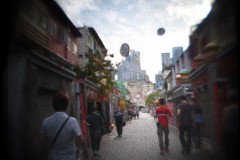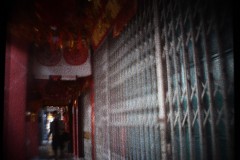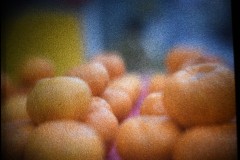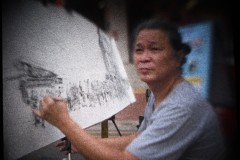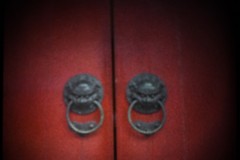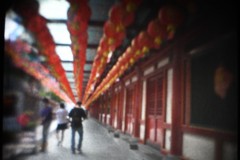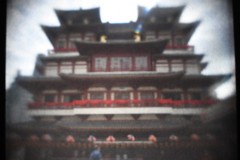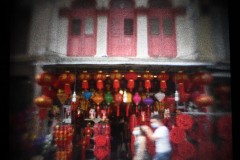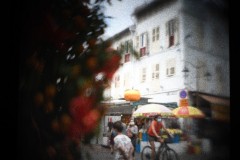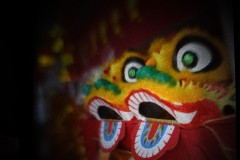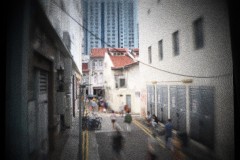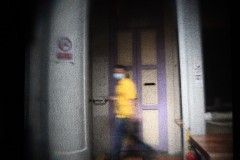
What is a camera obscura?
A camera obscura is simply light tight box with an opening (which can be a lens) that allows light into the box. It differs from a camera because a camera obscura can’t capture an image. The viewer can see the live view of what is happening outside of the box. My camera obscura is a small wooden box with a mirror inside and a lens used to focus the image. The image that is projected on the frosted glass plate is reversed so what is on the right is projected on the left and vice versa.
So how do I capture images that I view on my camera obscura? My camera obscura has an attachment which allows me to mount a camera above the glass plate and capture a picture of the projected image. The problem with the wooden attachment is that it blocks the view of the glass plate. So I use live view on my camera to view what is on the screen.
I mounted my Nikon D850 above the camera with a 24mm F1.4 lens. Then I chose the prime lens because it is smaller than a zoom like the 24-70mm F2.8 and I didn’t have to worry about accidentally zooming the lens at any point. I did have to crop the images to the square format later otherwise the image had a lot of black on the sides of the frame.
I used a wired shutter release cord that allowed me to capture an image without having to reach up and touch the camera’s shutter release button. I could have also enabled the Nikon D850‘s LCD touch display which allows me to touch the screen to capture an image. However, I didn’t because I wanted to reduce the chance of camera shake so the less I touched the camera, the better.
Lessons I Learned from Using Camera Obscura
I understand that not everyone will get the chance to use a camera obscura like the one I own. But everyone can learn some of the lessons that I learned from using my camera obscura.
Lesson 1 – Slow Down
One thing about using my camera obscura is that it takes a lot of time to set up. I have to put the camera on a tripod and move the tripod back and forth and left and right to get the composition right.
To focus, I have to move the lens on the front of the camera back and forth. The image doesn’t have a lot of depth of field so this process can take a little bit of time to get the image in focus. If I have a subject that is moving towards or away from the camera, it isn’t really possible for me to adjust the focus as that subject moves. I need to focus the camera on a part of the scene.
When I focus on something that is quite close to the camera, I get a very shallow depth of field. It is actually a beautiful image that this camera sees. Focus is even more important when I am close to a subject because of that narrow depth of field.
The lens doesn’t have an aperture so I can’t increase the depth of field and I just have to make the image work for me. All of this makes me slow down and be very deliberate with my choices of what to subject I want to photograph.
When using a regular camera, it is easy to just point my camera at something and quickly capture an image. With the camera obscura, I needed to assess my subjects more carefully because it took time to set up and frame an image.
The process of assessing an image and slowing down is something that is important for any photographer.
Lesson 2 – Patience
Because I was forced to slow down, I had to be patient with every image I was going to capture. When I am out photographing with just my regular camera there are times when I would love someone to walk into the scene to add a point of focus or interest to my image. Sometimes someone will come and sometimes I lose patience and just move on.
When it comes to photographing with the camera obscura, it takes me so much time to get set up and focused that it is much easier for me to wait for someone to come into the scene. I have already spent all this time setting up so what is a bit more time?
The camera obscura isn’t a camera that I can use when I see something quickly unfolding that I only have a few seconds to get in the right place to capture an image. It is a camera that I can find the right place and get set up there and wait for something to develop.
One other thing that was very helpful and allowed me to capture images of people in my image was the black cloth that I put my head under to capture the picture. People are busy and they see I have been set up in a spot for a while and I am taking my time so they tend to just go about and do what they were normally doing. Being able to be under the black cloth was a great way to be hidden from the outside world but still be able to see what was happening.
You probably don’t have a camera obscura, so what can you do?
Anyone can use the lessons of patience and slowing down to capture images to help improve their photography even if you don’t have a camera obscura.
Start with a prime lens so you can’t zoom. It doesn’t matter which focal lens of prime lens you use but this is probably easier with a shorter focal length like a 50mm or 35mm.
Put you camera and lens on a tripod. This is essential to helping you slow down. When you need to move your camera up or down you have to adjust the legs of the tripod and it takes time. This forces you to be deliberate and make sure that your framing is just right.
Set your lens to its widest aperture for minimum depth of field and set your camera and lens to manual focus. Use live view mode so you can see the scene on your camera’s LCD display. If you want, you can even shut yourself off from the world by using a large cloth to cover yourself and the back of the camera. Just make sure the cloth doesn’t cover up the lens! It may also be helpful to use a cable release to capture an image so you don’t have to reach around and press the camera’s shutter release button. Give it a shot.
